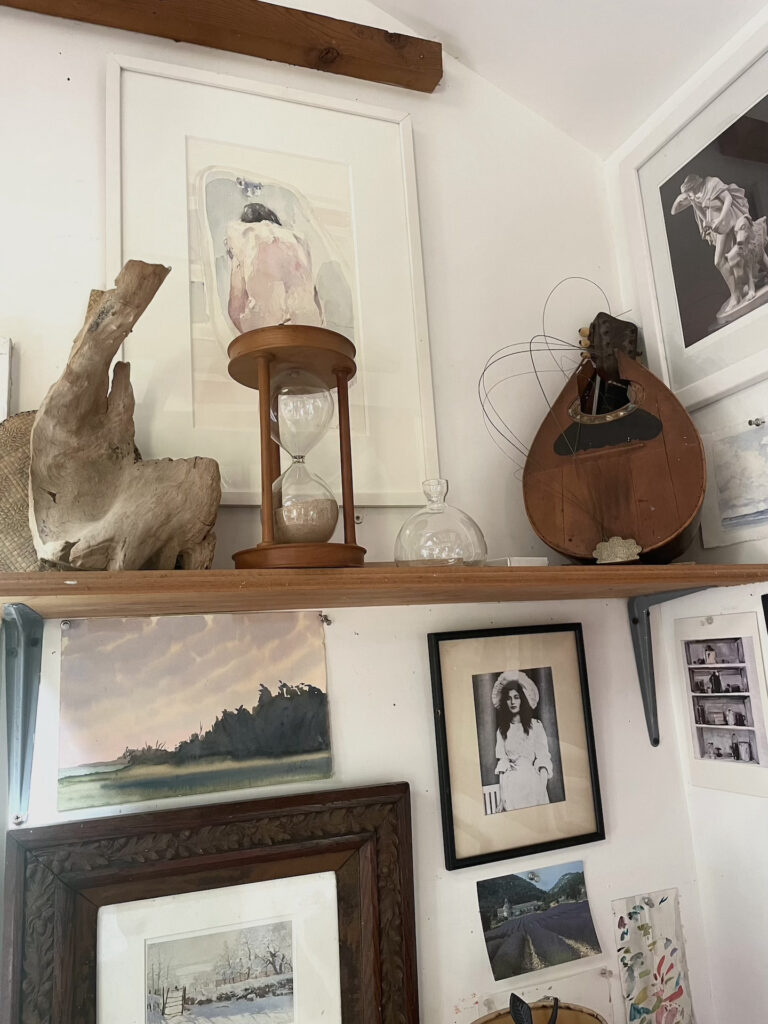All photos courtesy of the author.
Article continues below
Most mornings, gripping my computer in one hand and a mug of coffee in the other, I descend a set of stairs curling around lichen-smeared boulders, down to the door of my dad’s old painting studio, which, since he moved to a new studio decades ago, is where I write.
The building isn’t very big—about the size of Thoreau’s cabin. It’s a hundred or so feet from our house, close to a salt marsh. I put my computer on a long wooden farm table pushed up against the west window. I sit in a yellow chair—one of my dad’s, from his days painting here—that has dashes of color all over it, where he must have wiped his brush in a hurry. I spent so many childhood afternoons in this studio, and know enough about my dad’s oil paintings, that I recognize most of the colors on the chair in their specific names from the tubes: cerulean blue; Prussian blue; olive green; sap green; mauve; Payne’s gray, etc.
The studio is a century old. You’d have to renovate if you wanted to live in here, but it’s just comfortable enough for a few hours a day, despite the smells, which, depending on the season, are wood stain, dust, mold, and sometimes, when it’s really warm, the thinnest traces of turpentine from decades of it dripping off my dad’s paintbrushes and onto the floorboards. Before my dad made this his studio, it was my great-grandfather’s toolshed, and still has that casual utilitarian look, the way it sits alone on the hillside with its the weatherworn shingles, ivy running over sealed windows, and birds’ nests tucked above doorways and windows. Walking to the studio this morning, I noticed an oak tree sapling growing in the gutter. There’s always a construction project at the house that overrules what’s needed here, so it floats along, on the edge of disrepair. During nor-easters, rainwater pushes under the door to make a large puddle on the wooden floor, which takes care of itself by drying up in a few days’ time.
Perhaps my favorite thing about writing here is that it’s too far from the house for the internet. After that, it’s the quiet. So quiet that, in the summer, I can identify most of the birdcalls in the surrounding trees. A trapped housefly, flinging itself into the windows from one side of the room to the other, is such an ear-splitting disruption that I stop writing until it makes its way to the opened door. I run outside to chase squirrels off the roof because of their rasping footsteps. A woodpecker searching for bugs in the shingles prompts a coffee break back up at the house. In fact, the boundary between the animal and human space is, well, relaxed around here. I keep the spiders around because I appreciate the work they do on the houseflies. I quite like watching a line of ants on the wall, am wondrously shocked that they all know where they’re going. Every spring I find at least one old tool drawer filled with acorns from a cheeky squirrel, and it always makes me smile.
I can look at every object listed above and tell a story about each.
Now that my dad’s paintings and easels and brushes have gone, the space inside looks like something between an antiques shop and a walk-in cabinet of curiosities (years of collecting for still life drawings). From where I sit, I can see three pinned butterflies, a half dozen skeleton keys, pressed seaweeds framed behind glass, a small bucket of colorful buttons, three dolphin teeth, an antique meat cleaver the size of a small flipper, old glass bottles, two papery wasp nests, an apple picking basket, more than a dozen mismatched dice of varying off-whites, owl feathers, heirloom spotted beans, dried flowers hanging from the rafters, bell jars, carved wooden statues, animal skulls, bird eggs, seashells, an old hammer, defunct paintbrushes, sea glass, fish vertebra, black-and-white photographs of French Impressionist painters, more sketches and paintings and prints than I can count, and much, much more—all nailed to the walls or sitting on windowsills or crammed onto bookshelves. There’s a molasses colored mandolin on a shelf high above my writing desk—the bulging kind that looks like a giant pear. The neck has broken and collapsed into the body. For the longest time, I thought the mandolin must be something my dad had acquired for a drawing. Then, last year, my mom, visiting the studio, told me offhandedly that her ex-boyfriend had given it to her, back in the 1970s, as a parting gift from a farm they were living on in Kentucky, which to me sounded weirdly like a story that could have come right out of my new book.

In fact, it’s no surprise that I wrote nearly my whole book—a story collection centering on objects connecting people through time—in this studio. I can look at every object listed above and tell a story about each. The pressed seaweed behind glass? Sent from a friend in Maine, whom I met nearly fifteen years ago while I was studying birds at a marine research station, and with whom I’ve lost touch, and so, whenever I look at the pressed seaweed, feel a small scoop of loss for my twenties. The carved statues? Collected by my great-grandmother when she got on a ship going around the world a couple years after her son died in World War II. Even the old hammer on the workbench is one that I recognize from a charcoal drawing my dad made in the 1980s. The drawing was so astoundingly real and masterfully done—I still stare at it, on the wall of his new studio—that, as a kid, it convinced me he had special powers. It’s a notion I often experienced, that my parents were all-knowing and powerful near magicians, who could, aside from rendering three-dimensional objects with nothing but a pencil, conjure warmth and stories and trips to the ice cream store. Maybe it’s a feeling most people have, and for which they feel a similar sharp nostalgia—when you saw your parents as infallible demigods, even if they weren’t. It’s a vision I miss, though I know it’s unfair to them. Anyway, I’m glad I have the hammer to at least remind me of that feeling, which, I think is why I’ve barely changed a thing in the studio, including painting over the walls that are in desperate need of a fresh coat. If I did that, I’d lose my dad’s paintbrush marks on the walls, which, to me, are some of the most prized artifacts in my writing space.
__________________________________

The History of Sound by Ben Shattuck is available from Viking Books, an imprint of Penguin Publishing Group, a division of Penguin Random House, LLC.
